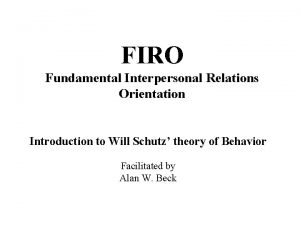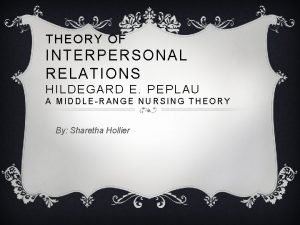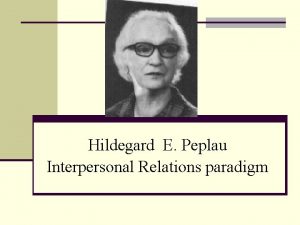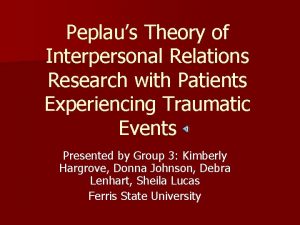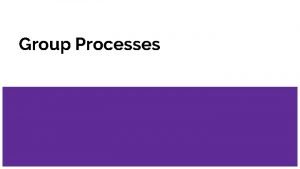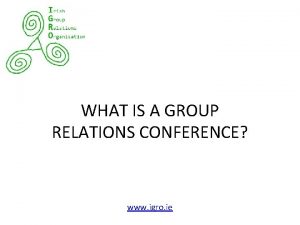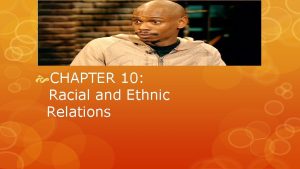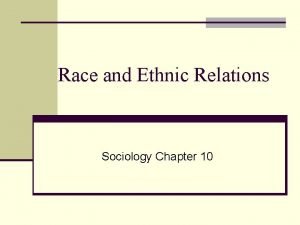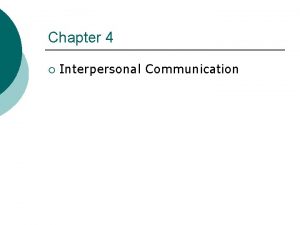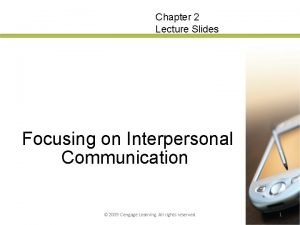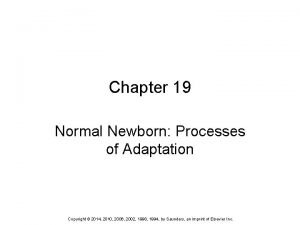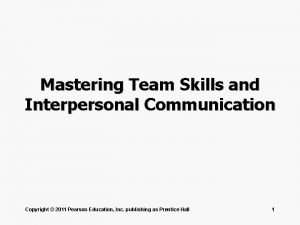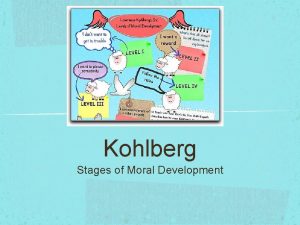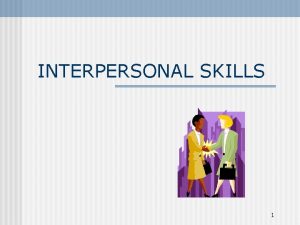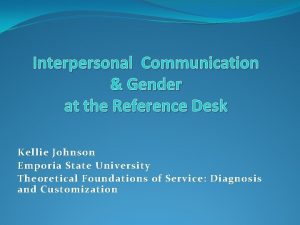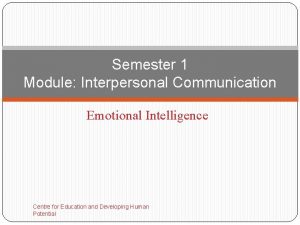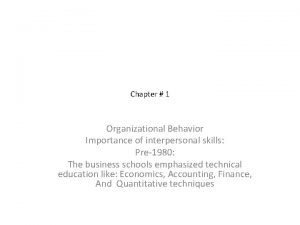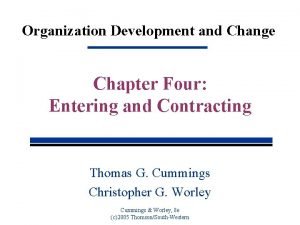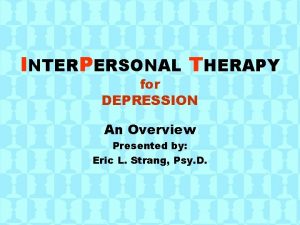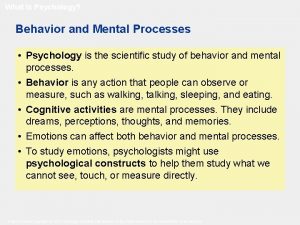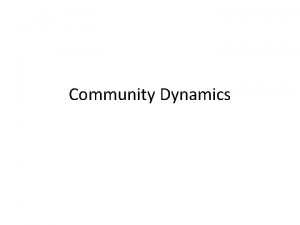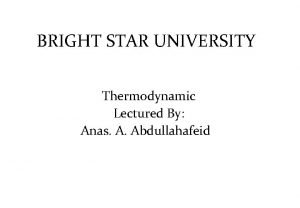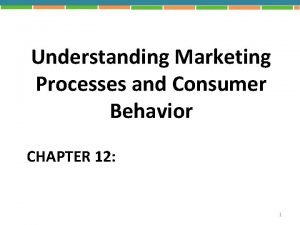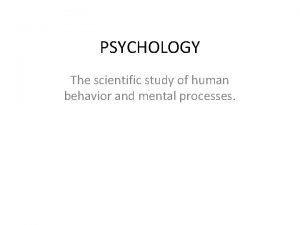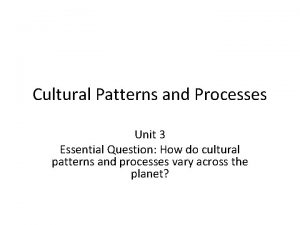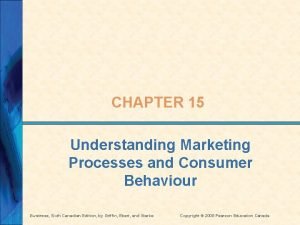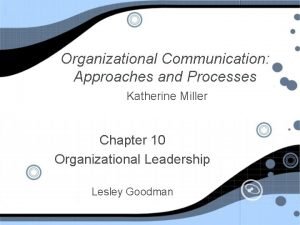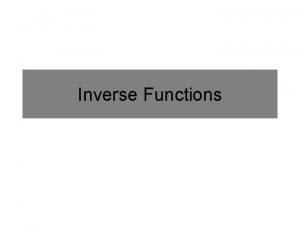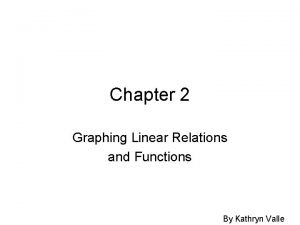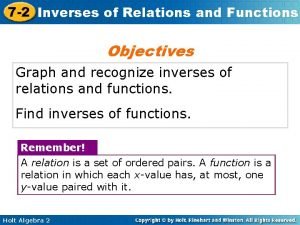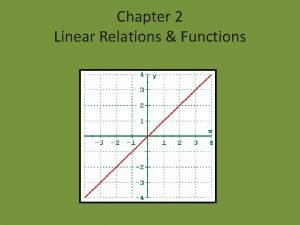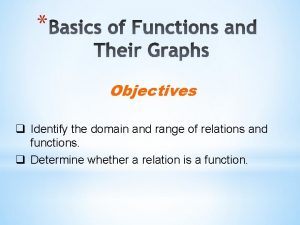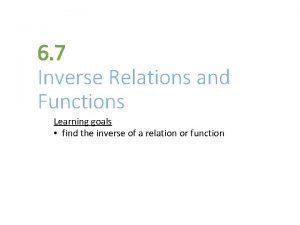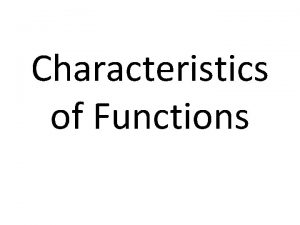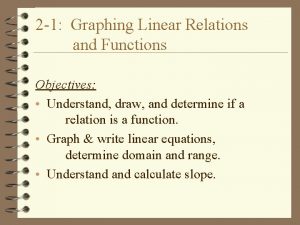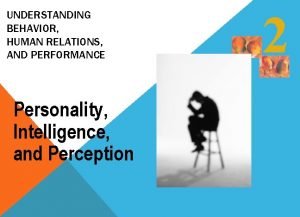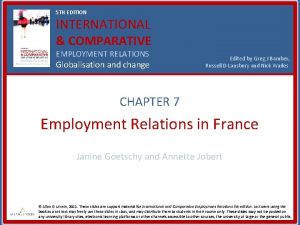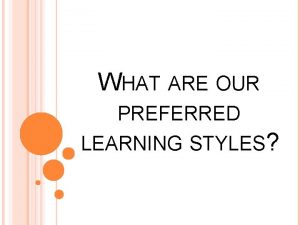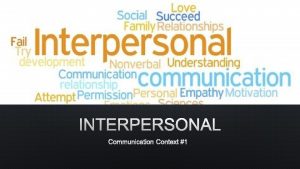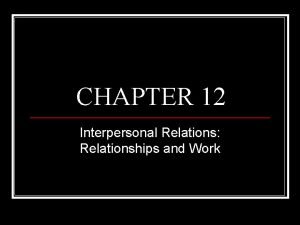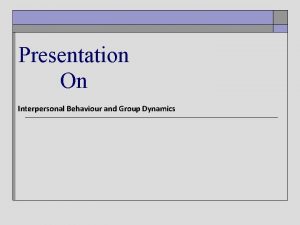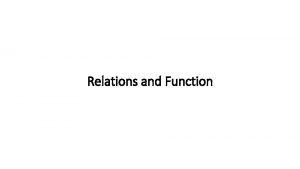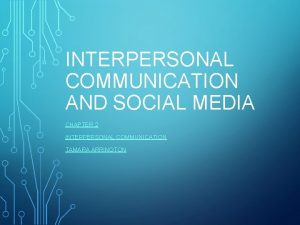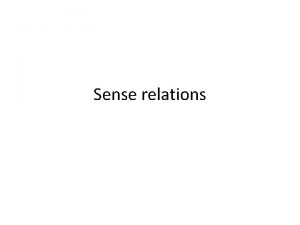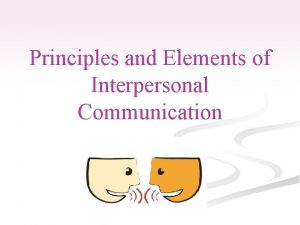CHAPTER 18 INTERPERSONAL RELATIONS AND GROUP PROCESSES Chapter



































































































































- Slides: 131

CHAPTER 18 INTERPERSONAL RELATIONS AND GROUP PROCESSES

Chapter plan n n INTRODUCTION INTERPERSONAL BEHAVIOUR n Being in the presence of other people n The influence of authority n Affiliation, attraction and close relationships GROUP PROCESSES n Taking our place in the group n How groups influence their members n How groups get things done INTERGROUP RELATIONS n Deindividuation, collective behaviour and the crowd n Cooperation and competition between groups n Social categories and social identity n Prejudice and discrimination n Building social harmony SUMMARY

n One of the most distinctive aspects of human beings is that we are social. n We are each affected by the presence of other people, we form relationships with other people we join groups with other people, and we behave in certain ways towards members of our own and other groups. n In the last chapter we looked at various aspects of social evaluation and how we process social information – intra-personal processes. n In this chapter, we look more broadly at the ways in which our behaviour is genuinely social.

Interpersonal behaviour Being in the presence of other people: Social facilitation n Intuitively, most of us probably think the term ‘social’ means doing things with (or being in the presence of) other people, and that social psychology is therefore about the causes and effects of this ‘social presence’. n Although social psychologists tend to use the term ‘social’ in a much broader way than this, the effect of the physical presence of other people on our behaviour remains an important research question (Guerin, 1993).

n F. Allport (1920) coined the term social facilitation to refer to a clearly defined effect in which the mere presence of conspecifics (i. e. members of the same species) would improve individual task performance. n However, later research found that the presence of conspecifics sometimes impairs performance, although it was often unclear what degree of social presence produced impairment (i. e. coaction or a passive audience).

n Zajonc (1965) put forward a drive theory to explain social facilitation effects. n He argued that, because people are unpredictable, the mere presence of a passive audience instinctively and automatically produces increased arousal and motivation. n This was proposed to act as a drive that produces dominant responses for that situation (i. e. well learned, instinctive or habitual behaviours that take precedence over alternative responses under conditions of heightened arousal or motivation).

n Zajonc argued that if the dominant response is the correct behaviour for that situation (e. g. pedalling when we get on a bicycle), then social presence improves performance (social facilitation). n But if the dominant response is an incorrect behaviour (e. g. trying to write notes in a lecture before we have understood properly what is being said), then social presence can impair performance (social inhibition).

Zajonc’s (1965) explanation of social facilitation/inhibition. (Fig. 18. 1)

n Overall, the main empirical finding from this body of research is that the presence of others improves performance on easy tasks, but impairs performance on difficult tasks. n But no single explanation seems to account for social facilitation and social inhibition effects (Guerin, 1993). n In fact, several concepts – including arousal, evaluation apprehension, and distraction conflict – have been implicated.

Bystander apathy and intervention n One type of behaviour that might be affected by the presence of other people is our inclination to offer help to someone who needs it; this question can be studied from many perspectives. n Two of the most important lines of research on helping by social psychologists have focused on situational factors that encourage or discourage helping, and on what motives may underlie helping others.

n A critical feature of the immediate situation that determines whether bystanders help someone who is in need of help (bystander intervention) is the number of potential helpers who are present. n Numerous studies indicate that the willingness to intervene in emergencies is higher when a bystander is alone.

When there are several bystanders, it is less likely that a victim will receive help. (Fig. 18. 2)

n Subsequent research has indicated that three types of social process seem to cause the social inhibition of helping in such situations: 1. 2. 3. diffusion of responsibility (when others are present, our own perceived responsibility is lowered); ignorance about how others interpret the event; feelings of unease about how our own behaviour will be evaluated by others present.

The effect of the presence and identity of others on bystander intervention in an emergency. (Fig. 18. 3)

n On the basis of studies such as this, Latané and Darley (1970) proposed a cognitive model of bystander intervention. n Helping (or not) was considered to depend on a series of decisions: 1. noticing that something is wrong; 2. defining it as an emergency; 3. deciding whether to take personal responsibility; 4. deciding what type of help to give; and 5. implementing the decision.

n Bystanders also seem to weigh up costs and benefits of intervention vs. apathy before deciding what to do. n Piliavin, Dovidio, Gaertner and Clark (1981) proposed a bystander calculus model that assigns a key role to arousal. n They proposed that emergencies make us aroused, situational factors determine how that arousal is labelled and what emotion is felt, and then we assess the costs and benefits of helping or not helping before deciding what to do.

Motives for helping n A rather different line of research has concentrated on the motives underlying helping (or, more generally, prosocial behaviour) – in particular, whether people help for altruistic or egoistic motives. n Batson proposed an altruism theory, whereas others have taken the view that people help for selfish, rather than altruistic, motives.

Percentage of participants who helped Elaine, depending on similarity/empathy and difficulty of escape. (Fig. 18. 4)

n It has been proposed that helping could sometimes be motivated by an egoistic desire to gain relief from a negative state (such as distress, guilt or unhappiness) when faced with another person in need of help. n A meta-analysis by Carlson and Miller (1987) did not support this idea, but there is continued controversy between the ‘altruists’ and ‘egoists’ as to why we help others. n Batson (e. g. , 1991) continues to maintain that helping under the conditions investigated by him is motivated positively by the feeling of ‘situational empathy’, rather than by an egoistic desire to relieve the ‘situational distress’ of watching another person suffer.

n Helping is increased by prosocial societal or group norms. n These can be general norms of reciprocity (‘help those who help you’) or social responsibility (‘help those in need’), or more specific helping norms tied to the nature of a social group (‘we should help older people’). n Other factors that increase helping include being in a good mood and assuming a leadership role in the situation. n Research has also shown that, relative to situational variables, personality and gender are poor predictors of helping.

The influence of authority n Research on both social facilitation and helping shows that the mere presence of other people can have a clear effect on behaviour. n But this effect can be tremendously amplified if those others actively try to influence us – for example, from a position of authority. n Legitimate authority figures can be particularly influential; they can give orders that people blindly obey without really thinking about the consequences; e. g. Milgram’s famous experiments published in the 1960 s.

n Milgram’s work showed that apparently ‘pathological’ behaviour may not be due to individual pathology (the participants were ‘normal’) but to particular social circumstances. n The situation encouraged extreme obedience. Milgram (1965, 1974) subsequently conducted a whole series of studies using this paradigm. n One of his most significant findings was that social support is the single strongest moderator of the effect: obedience is strengthened if others are obedient, and massively reduced if others are disobedient.

Obedience as a function of peer behaviour. (Fig. 18. 5)

n One unanticipated consequence of Milgram’s research was a fierce debate about the ethics of social psychological research. n Although no electric shocks were actually given in Milgram’s study, participants genuinely believed that they were administering shocks and showed great distress. n Was it right to conduct this study?

n n This debate led to strict guidelines for psychological research. Three of the main components of this code are: i. that participants must give their fully informed consent to take part; ii. that they can withdraw at any point without penalty; and iii. that after participation they must be fully debriefed.

Affiliation, attraction and close relationships Seeking the company of others n Human beings have a strong need to affiliate with other people, through belonging to groups and developing close interpersonal relationships. n Our motives for affiliation include social comparison (we learn about ourselves, our skills, abilities, perceptions and attitudes), anxiety reduction and information seeking.

n People usually seek out and maintain the company of people they like. n We tend to like others whom we consider physically attractive, and who are nearby, familiar and available, and with whom we expect continued interaction. n We also tend to like people who have similar attitudes and values to our own, especially when these attitudes and values are personally important to us.

The importance of social support n Generally, having appropriate social support is a very powerful ‘buffer’ against stressful events. n Cohen and Hoberman (1983) found that, among individuals who felt that their life was very stressful, those who perceived themselves to have low social support reported many more physical symptoms (e. g. headaches, insomnia) than those who felt they had high social support. n Overall, the evidence is clear – social integration is good for our physical and psychological health.

The relationship between perceived stress and physical symptomatology for individuals low and high in social support. (Fig. 18. 6)

Social exchange theory n A general theoretical framework for the study of interpersonal relationships is social exchange theory (Thibaut & Kelley, 1959). n This approach regards relationships as effectively trading interactions, including goods (e. g. birthday presents), information (e. g. advice), love (affection, warmth), money (things of value), services (e. g. shopping, childcare) and status (e. g. evaluative judgements). n A relationship continues when both partners feel that the benefits of remaining in the relationship outweigh the costs and the benefits of other relationships.

n According to the more specific equity theory, partners in intimate relationships are happier if they feel that both partners’ outcomes are proportional to their inputs, rather than one partner receiving more than they give. n Equity theory assumes that satisfaction in a relationship is highest when the ratio of one’s own outcomes to inputs is equal to that of a referenced other (individuals will try to restore equity when they find themselves in an inequitable situation).

Happy vs. distressed relationships n A major characteristic of happy, close relationships is a high degree of intimacy. n According to Reis and Patrick (1996), we view our closest relationships as intimate if we see them as: n caring (we feel that the other person loves and cares about us); n understanding (we feel that the other person has an accurate understanding of us); and n validating (our partner communicates his or her acceptance, acknowledgement and support for our point of view).

n Unhappy or ‘distressed’ relationships, on the other hand, are characterized by higher rates of negative behaviour, reciprocating with such negative behaviour when the partner behaves negatively towards us. n Reciprocation, or retaliation, is the most reliable sign of relationship distress. n Those in unhappy relationships also tend to ignore or cover up differences, compare themselves negatively with other couples and perceive their relationship as less equitable than others. n They also make negative causal attributions of their partner’s behaviours and characteristics.

The investment model n Ultimately, what holds a relationship together is commitment – the inclination to maintain a relationship and to feel psychologically attached to it. n According to the investment model, commitment is based on one or more of the following factors: high satisfaction, low quality of alternatives, and a high level of investments. n Highly committed individuals are more willing to make sacrifices for their relationship, and to continue it even when forced to give up important aspects of their life.

n Relationship break-ups can be devastating for both partners. n The physical and mental health of divorced people is generally worse than that of married people, or even people who have been widowed or never married. n Factors that predict better adjustment to divorce include having taken the initiative to divorce, being embedded in social networks, and having another satisfying and intimate relationship.

Group processes Taking our place in the group n Almost all groups are structured into specific roles. n People move in and out of roles, and in and out of groups. n Groups are dynamic in terms of their structure and their membership. n First of all, people need to join groups.

Joining groups n We join groups for all sorts of reasons, but in many cases we are looking for company (e. g. friendships and hobby groups) or to get things done that we cannot do on our own (e. g. therapy groups, work groups and professional organizations). n We also tend to identify with large groups (social categories) that we belong to – national or ethnic groups, political parties, religions, and so forth.

n One view is that joining a group is a matter of establishing bonds of attraction to the group, its goals and its members; so a group is a collection of people who are attracted to one another in such a way as to form a cohesive entity. n Another perspective, based on social comparison theory, is that we affiliate with similar others in order to obtain support and consensus for our own perceptions, opinions and attitudes. n A third approach rests on social identity theory; according to this framework, group formation involves a process of defining ourselves as group members, and conforming to what we see as the stereotype of our group, as distinct from other groups.

Group development n The process of joining and being influenced by a group doesn’t generally happen all at once. n It is an ongoing process. n The relevant mechanisms have been investigated by many social psychologists interested in group development, or how groups change over time.

n One very well established general model of group development is Tuckman’s five-stage model (1965; Tuckman & Jensen, 1977): n forming – initially people orient themselves to one another; n storming – they then struggle with one another over leadership and group definition; n norming – this leads into agreement on norms and roles; n performing – the group is now well regulated internally and can perform smoothly and efficiently; n adjourning – this final stage involves issues of independence within the group, and possible group dissolution.

n More recently, Levine and Moreland (1994) have provided a detailed account of group socialization – how groups and their members adapt to one another, and how people join groups, maintain their membership and leave groups. n Levine and Moreland believe that people move through these different roles during the lifetime of the group.

n Levine and Moreland’s (1994) approach highlights five generic roles that people occupy in groups: n prospective member – potential members reconnoitre the group to decide whether to commit; n new member – members learn the norms and practices of the group; n full member – members are fully socialized, and can now negotiate more specific roles within the group; n marginal member – members can drift out of step with group life, but may be re-socialized if they drift back again; and n ex-member – members have left the group, but previous commitment has an enduring effect on the group and on the ex-member.

Roles n Almost all groups are internally structured into roles; these prescribe different activities that exist in relation to one another to facilitate overall group functioning. n In addition to task-specific roles, there also general roles that describe each member’s place in the life of the group (e. g. newcomer, old-timer). n Rites of passage, such as initiation rites, often mark movement between generic roles, which are characterized by varying degrees of mutual commitment between member and group.

n Roles can be very real in their consequences (e. g. Zimbardo et al. , 1982). n Roles also define functions within a group, and the different parts of the group normally need to communicate with one another (e. g. research on communication networks focuses on centralization as the critical factor).

Some communication networks that have been studied experimentally. (Fig. 18. 7)

Leadership n The most basic role differentiation within groups is into leaders and followers. n Are some people ‘born to lead’ (think of Margaret Thatcher, Sir Earnest Shackleton or Sir Alex Ferguson), or do they acquire leadership personalities that predispose them to leadership in many situations?

Are some people ‘born to lead’, or do they acquire leadership personalities that predispose them to leadership? (Fig. 18. 8)

n Extensive research has revealed that there almost no personality traits that are reliably associated with effective leadership in all situations (Yukl, 1998). n This finding suggests that many of us can be effective leaders, given the right match between our leadership style and the situation.

n Leader categorization theory states that we have leadership schemas (concerning what the leader should do and how) for different group tasks, and that we categorize people as effective leaders on the basis of their ‘fit’ to the task-activated schema. n A variant of this idea, based on social identity theory, is that in some groups what really matters is that you fit the group’s defining attributes and norms and that, if you are categorized as a good fit, you will be endorsed as an effective leader.

n Perhaps the most enduring leadership theory in social psychology is Fiedler’s (1965) contingency theory; Fiedler believed that the effectiveness of a particular leadership style was contingent (or dependent) on situational and task demands. n He distinguished between two general types of leadership style (people differ in terms of which style they naturally adopt): 1. a relationship-oriented style that focuses on the quality of people’s relationships and their satisfaction with group life; and 2. a task-oriented style that focuses on getting the task done efficiently and well.

n A substantial amount of research has shown that task-oriented leaders are superior to relationshiporiented leaders when situational control is very low (i. e. poorly structured task, disorganized group) or very high (i. e. clearly structured task, highly organized group). n But relationship-oriented leaders do better in situations with intermediate levels of control.

n Fiedler’s model of leadership is, however, a little static. n Other approaches have focused instead on the dynamic transactional relationship between leaders and followers. n According to these approaches, people who are disproportionately responsible for helping a group achieve its goals are subsequently rewarded by the group with the trappings of leadership, in order to restore equity.

n Leaders who have a high idiosyncrasy credit rating are imbued with charisma by the group, and may be able to function as transformational leaders. n Charismatic transformational leaders are able to motivate followers to work for collective goals that transcend self-interest and transform organizations. n They are proactive, change-oriented, innovative, motivating and inspiring and have a vision or mission with which they infuse the group.

How groups influence their members n We have seen how the presence of other people can make us less inclined to help someone, and how other people can persuade us to obey their orders. n Groups can also exert enormous influence on individuals through the medium of norms (Turner, 1991).

Group norms n Although group norms are relatively enduring, they do change in line with changing circumstances to prescribe attitudes, feelings and behaviours that are appropriate for group members in a particular context. n Norms relating to group loyalty and central aspects of group life are usually more specific, and have a more restricted range of acceptable behaviour than norms relating to more peripheral features of the group. n High-status group members also tend to be allowed more deviation from group norms than lower-status members (Sherif & Sherif, 1964).

n Sherif (1935, 1936) carried out one of the earliest, and still most convincing demonstrations of the impact of social norms, deliberately using an ambiguous stimulus. n Autokinetic effect: optical illusion in which a stationary point of light shining in complete darkness appears to move about.

n Participants who first made their judgements alone developed rather quickly a standard estimate (a personal norm) around which their judgements fluctuated; this personal norm was stable within individuals, but it varied highly between individuals. n In the group phases of the experiment, which brought together people with different personal norms, participants’ judgements converged towards a more or less common position – a ‘group norm’. n In subsequent studies, Sherif found that, once established, this group norm persisted, and that it strongly influenced the estimations of new members of the group.

Median estimates of movement under solitary (I) or group (II, IV) conditions (left), and under group (I, III) or solitary (IV) conditions (right) in a research study on norm formation which used the autokinetic phenomenon. (Fig. 18. 9)

Conformity n In Sherif’s experiments, people may have conformed for one of two reasons, each linked to a distinct form of social influence (Deutsch & Gerard, 1955): 1. They may have been concerned about social evaluation (e. g. being liked or being thought badly of) by the others in the group (normative influence). 2. They may have used the other group members’ judgements as useful information to guide them in an ambiguous task on which they had no previous experience (informational influence).

n A series of experiments by Asch (1951, 1952, 1956) tried to rule out informational influence by using clearly unambiguous stimuli. n In his first study, Asch invited students to participate in an experiment on visual discrimination.

n The results reveal the powerful influence of an obviously incorrect but unanimous majority on the judgements of a lone participant. n In comparison with the control condition (which yielded only 0. 7 per cent errors), the experimental participants made almost 37 per cent errors; not every participant made that many errors, but only about 25 per cent of Asch’s 123 participants did not make a single error. n Presumably, conformity was produced through normative social influence operating in the judgement task.

An example of the stimuli presented in Asch’s (1956) research on conformity. (Fig. 18. 10)

Conformity as a function of social support. (Fig. 18. 11)

n Conformity: social influence resulting from exposure to the opinions of a majority of group members or to an authority figure – typically superficial and short-lived.

n Subsequent Asch-type experiments have investigated how majority influence varies over a range of social situations (e. g. Allen, 1975; Wilder, 1977). n These studies found that conformity reaches full strength with three to five apparently independent sources of influence. n Larger groups of independent influence are not stronger, which perhaps runs counter to our intuitions.

n Non-independent sources (e. g. several members of the same coalition or subgroup) are seemingly treated as a single source. n Conformity is significantly reduced if the majority is not unanimous. n Dissenters and deviates of almost any type can produce this effect.

Minority influence n For most of us, conformity means coming into line with majority attitudes and behaviours; but what about minority influence? n Minorities face a social influence challenge. n By definition, they have relatively few members; they also tend to enjoy little power, can be vilified as outsiders, hold ‘unorthodox’ opinions, and have limited access to mainstream mass communication channels. n And yet minorities often prevail, bringing about social change.

n Research suggests that minorities must actively create and accentuate conflict to draw attention to themselves and achieve influence. n The film Twelve Angry Men provides a dramatic fictitious example of how minority influence occurs. n Other examples of minority influence include Bob Geldof’s Band Aid movement to raise money for famine relief, and new forms of music and fashion.

n Moscovici (1980) proposed a dual-process theory of majority/ minority influence, suggesting that people conform to majority views fairly automatically, superficially and without much thought because they are informationally or normatively dependent on the majority. n In contrast, effective minorities influence by conversion. n The deviant message achieves little influence in public, but it is processed systematically to produce influence (e. g. attitude change) that emerges later, in private and indirectly.

n But support for Moscovici’s dual-process theory is mixed. n Overall, the weight of evidence is tipped slightly towards Moscovici’s claim that minorities instigate deeper processing of their message (see Martin & Hewstone, 2003 a, b). n Nemeth (1986, 1995) proposed that minorities induce more divergent thinking (thinking beyond a focal issue), whereas majorities induce more convergent thinking (concentrating narrowly on the focal issue).

How groups get things done n Most groups exist to get things done, including making decisions and collaborating on group projects. n Working in groups has some obvious attractions – more hands are involved, the human resource pool is enlarged, and there are social benefits. n Yet group performance is often worse than you might expect.

n Potential group gains in effectiveness and creativity seem to be offset by negative characteristics of group performance, including the tendency to let others do the work, suboptimal decision making, and becoming more extreme as a group than as individual members. n Some of these drawbacks are due to problems of coordination, and others are due to reduced individual motivation.

Social loafing n Individual motivation can suffer in groups, particularly where the task is relatively meaningless and uninvolving, the group is large and unimportant, and each individual’s contribution to the group is not personally identifiable. n This phenomenon has been termed social loafing.

Intensity of sound generated person (as proportion of individual potential) when cheering as a single individual, or as a member of real or pseudo two-person or six-person groups. (Fig. 18. 12)

n Subsequent research using this and similar paradigms has shown that social loafing is minimized when groups work on challenging and involving tasks, and when group members believe that their own inputs can be fully identified and evaluated through comparison with fellow members or with another group. n In fact, when people work either on important tasks or in groups which are important to them, they may even work harder collectively than alone – so, in these circumstances, ‘social loafing’ turns into ‘social striving’.

We often work harder on group activities, especially when the task is challenging and involving. (Fig. 18. 13)

Group decision making n An important group function is to reach a collective decision, through discussion, from an initial diversity of views. n Research on social decision schemes identifies a number of implicit or explicit decision-making rules that groups can adopt to transform diversity into a group decision (Stasser, Kerr & Davis, 1989).

n These include: n unanimity – discussion puts pressure on deviants to conform; n majority wins – discussion confirms the majority position, which becomes the group decision; n truth wins – discussion reveals the position that is demonstrably correct; and n two-thirds majority – discussion establishes a two-thirds majority, which becomes the group decision.

n The type of rule that is adopted can affect both the group atmosphere and the decision-making process (Miller, 1989). n For example, unanimity often creates a pleasant atmosphere but can make decision making painfully slow, whereas ‘majority wins’ can make many group members feel dissatisfied but speeds up decision making. n Juries provide an ideal context for research on decision schemes; not only are they socially relevant in their own right, but they can be simulated under controlled laboratory conditions.

n For example, Stasser, Kerr and Bray (1982) found that a two-thirds majority rule prevails in many juries. n Furthermore, they discovered that it was possible to predict accurately the outcome of jury deliberations from knowledge of the initial distribution of verdict preferences (‘initial’ here means before any discussion has taken place). n If two thirds or more initially favoured guilt, then that was the final verdict, but if there was initially no two-thirds majority, then the outcome was a hung jury.

A jury rarely changes its overall decision during discussion. (Fig. 18. 14)

Group polarization and ‘groupthink’ n Popular opinion and research on conformity both suggest that groups are conservative and cautious entities, and that they exclude extremes by a process of averaging. n But two phenomena that challenge this view are group polarization and groupthink.

n Group polarization is the tendency for groups to make decisions that are more extreme than the average of pre-discussion opinions in the group, in the direction towards the position originally favoured by the average.

n The explanation for this lies partly in the same processes of informational and normative social influence we discussed earlier. n Group members learn from other group members’ arguments, and engage in mutual persuasion, but they are also influenced by where others stand on the issue, even if they do not hear each other’s arguments.

n This polarization is particularly likely to occur when an important group to which an individual belongs (i. e. an ingroup) confronts a salient group to which she does not belong (i. e. an outgroup) that holds an opposing view. n Mere repetition of arguments, which also tends to occur within groups (especially when the discussion lasts a long time, and all group members wish to express their views) can also produce polarization (Brauer & Judd, 1996).

n Groupthink is a more extreme phenomenon. n Janis (1972) argued that highly cohesive groups that are under stress, insulated from external influence, and which lack impartial leadership and norms for proper decision-making procedures, adopt a mode of thinking (groupthink) in which the desire for unanimity overrides all else. n The members of such groups apparently feel invulnerable, unanimous and absolutely correct; they also discredit contradictory information, pressurize deviants and stereotype outgroups.

n The consequences of groupthink can be disastrous – particularly if the decision-making group is a government body. n A dramatic example attributed to groupthink is the decision of NASA officials to press ahead with the launch of the space shuttle Challenger in 1986, despite warnings from engineers (see Esser & Lindoerfer, 1989). n The shuttle crashed seconds into its flight.

Brainstorming n A popular method of harnessing group potential is brainstorming – the uninhibited generation of as many ideas as possible, regardless of quality, in an interactive group. n Although it is commonly thought that brainstorming enhances individual creativity, research shows convincingly that this is not the case.

n Stroebe and Diehl considered various possible explanations for this finding. n They hypothesized that ‘process loss’ in brainstorming groups is due to an informal coordination rule of such groups which specifies that only one group member may speak at a time. n During this time, other group members have to keep silent, and they may be distracted by the content of the group discussion, or forget their own ideas.

n Stroebe and Diehl termed this phenomenon ‘production blocking’, because the waiting time before speaking and the distracting influence of others’ ideas could potentially block individuals from coming up with their own ideas. n Their results suggest that ‘production blocking’ is indeed an important factor explaining the inferiority of interactive brainstorming groups.

n This finding suggests that it may be more effective to ask group members to develop their ideas separately, and only then have these ideas expressed, discussed and evaluated in a subsequent joint meeting. n Of interest, electronic brainstorming (via computers linked on a network) can be very effective – the lack of face-to-face interaction may minimize production blocking.

Intergroup relations n Through the study of intergroup relations – how people in one group (the ‘ingroup’) think about and act towards members of another group (the ‘outgroup’) – social psychologists (e. g. Brewer & Brown, 1998; Hewstone, Rubin & Willis, 2002) seek to understand a range of critical issues, including: 1. crowd behaviour; 2. cooperation and competition between groups; 3. social identity; 4. prejudice and discrimination; and 5. how to replace social conflict with social harmony.

Deindividuation, collective behaviour and the crowd n Many researchers have emphasized the tendency of group members to act in unison, like a single entity. n Early writers on crowd behaviour (who were not trained social psychologists) tended to view collective behaviour as irrational, aggressive, antisocial and primitive – reflecting the emergence of a ‘group mind’ in collective/crowd situations (e. g. Le. Bon 1896/1908). n The general model is that people in interactive groups such as crowds are anonymous and distracted, which causes them to lose their sense of individuality and become deindividuated.

n Deindividuation is thought to prevent people from following the prosocial norms of society that usually govern behaviour, because they are no longer identifiable (and hence no longer feel compelled to conform to social norms). n It is argued that, in a crowd, people regress to a primitive, selfish and uncivilized behavioural level.

n More recent research has discarded the idea that crowds are irrational, and has concentrated instead on understanding how people in crowds develop a shared identity, a shared purpose and shared norms (Turner & Killian, 1972). n In crowd situations, people often identify very strongly with the group defined by the crowd, and therefore adhere very closely to the norms of the crowd (Reicher, 2001).

In a crowd, individuals will often identify very strongly with the group and adhere very closely to group norms. (Fig. 18. 15)

Cooperation and competition between groups n Sherif (1966; Sherif et al. , 1961; Sherif, White, & Harvey, 1955) provided a far-reaching and influential perspective on intergroup behaviour. n In a series of naturalistic field experiments on conflict and cooperation at boys’ camps in the United States in the early 1950 s, Sherif and colleagues studied group formation, intergroup competition and conflict reduction.

Ingroup favouritism in estimates of performance by other ingroup and outgroup members during intergroup competition. (Fig. 18. 16)

n Having found it so easy to trigger intergroup hostility, in the conflict reduction phase Sherif discovered how hard it was to reduce conflict. n The most effective strategy was to introduce a series of superordinate goals, i. e. goals that both groups desired but could only attain if they acted together. n For example, when the camp truck broke down delivering supplies, neither group could push-start it on their own; but both groups working together managed to move the truck by pulling on a rope attached to the front bumper.

Impact of competition vs. superordinate goals on negative stereotypes of the outgroup. (Fig. 18. 17)

n To explain his findings, Sherif focused on the importance of goals. n Mutually exclusive goals cause competitive intergroup behaviour, and superordinate goals improve intergroup relations. n As he pointed to the real nature of goal relations determining intergroup behaviour, Sherif ’s theory is often called realistic conflict theory.

n But Sherif’s studies also found that first expressions of in-group favouritism occurred in the group formation phase, when the groups were isolated from one another and knew only of each other’s existence. n So the mere existence of two groups seemed to trigger intergroup behaviour, before any mutually exclusive goals had been introduced!

Social categories and social identity n Experiments by Tajfel and colleagues provided the most convincing evidence that competitive goals are not a necessary condition for intergroup conflict. n In fact, merely being categorized as a group member can cause negative intergroup behaviour (Tajfel, Flament, Billig & Bundy, 1971).

n In Tajfel’s studies, participants were randomly divided into two groups and asked to distribute points or money between anonymous members of their own group and anonymous members of the other group. n There was no personal interaction, group members were anonymous, and the groups had no ‘past’ and no ‘future’ – for these reasons these groups are called ‘minimal groups’, and this experimental procedure is called the minimal group paradigm.

n The consistent finding of this research is that the mere fact of being categorized is enough to cause people to discriminate in favour of the ingroup and against the outgroup. n This research spawned the ‘social identity perspective’ on group processes and intergroup relations (Tajfel & Turner, 1986; see also Hogg & Abrams, 1988). n These processes produce a sense of group identification and belonging, as well as ingroup solidarity, conformity and bias.

n According to this social identity perspective, because groups define and evaluate who we are, intergroup relations are a continual struggle to gain superiority for the ingroup over the outgroup. n How the struggle is conducted – and the specific nature of intergroup behaviour (e. g. competitive, conflictual, destructively aggressive) – is thought to depend on people’s beliefs about the status relations between groups.

Prejudice and discrimination n Some of the most negative forms of intergroup behaviour are demonstrations of prejudice and discrimination. n Prejudice refers to a derogatory attitude towards a group and its members, whereas discrimination refers to negative behaviour. n The two are often closely interconnected.

Prejudiced personalities n Some theories of prejudice focus on personality, arguing that there are certain personality types that predispose people to intolerance and prejudice. n The best known of these theories concerns the authoritarian personality (Adorno, Frenkel. Brunswik, Levinson & Sanford, 1950); according to this view, harsh family rearing strategies produce a love–hate conflict in children’s feelings towards their parents.

n The conflict is resolved by idolizing all power figures, despising weaker others and striving for a rigidly unchanging and hierarchical world order. n People with this personality syndrome are thought to be predisposed to be prejudiced.

n This ‘personality’ approach has now been largely discredited, partly because it underestimates the importance of current situations in shaping people’s attitudes, and partly because it cannot explain sudden rises or falls in prejudice against specific racial groups (Brown, 1995). n On the other hand, a fairly small number of people do hold generalized negative attitudes towards all outgroups (e. g. the stereotypical bigot who dislikes blacks, Asians, gays and communists), and authoritarianism is indeed associated with various forms of prejudice (Altermeyer, 1988).

Society and identity n Contrary to personality explanations, by far the best predictor of prejudice is the existence of a culture of prejudice legitimized by societal norms. n For example, Pettigrew (1958) measured authoritarianism and racist attitudes among whites in South Africa, the northern United States and the southern United States. n He found more racist attitudes in South Africa and the southern United States than in the northern United States, but he found no differences in authoritarianism between these two groups.

n How do such prejudiced ‘cultures’ arise? n Both social identity theory (e. g. Tajfel & Turner, 1986) and social dominance theory (Pratto, 1999; Sidanius & Pratto, 1999) may provide part of the answer. n From the perspective of social dominance theory, people differ in their social dominance orientation [SDO] – the extent to which they desire their own group to be dominant and superior to outgroups. )

Modern forms of prejudice n Prejudiced attitudes are often deeply entrenched, may be passed from parents to children and are supported by the views of significant others. n Yet societal norms for acceptable behaviour can and do change, sometimes creating a conflict between personal feelings and how they can be expressed.

n Therefore, modern prejudice often presents itself as denial of the claim that minorities are disadvantaged, opposition to special measures to rectify disadvantage, and systematic avoidance of minorities and the entire question of prejudice against these minorities. n New, more subtle measures are required to detect these modern forms of prejudice (Pettigrew & Meertens, 1995); for example, increasing use is being made of implicit measures, which are beyond the intentional control of the individual, and so can detect prejudice even when people are aware of societal norms regarding tolerance or political correctness (see Cunningham, Preacher & Banaji, 2001).

Building social harmony n Prejudice and conflict are significant social ills that produce enormous human suffering, ranging from damaged self-esteem, reduced personal and professional opportunities, stigma and socioeconomic disadvantage, to intergroup violence, war and genocide. n Prejudice can be attacked by public service propaganda and educational campaigns, which convey societal disapproval of prejudice and may overcome some of the anxiety and fear that fuel it.

n But the problem with these strategies is that the very people being targeted may choose not to attend to the new information. n Two prominent social-psychological approaches to building social harmony avoid this problem by promoting increased positive intergroup contact and changing the nature of social categorization (Hewstone, 1996).

Intergroup contact n There is now extensive evidence for the contact hypothesis, which states that contact between members of different groups, under appropriate conditions, can improve intergroup relations. n Favourable conditions include cooperative contact between equal-status members of the two groups in a situation that allows them to get to know each other on more than a superficial basis, and with the support of relevant social groups and authorities.

n One difficulty is that, even if they do come to view some individuals from the other group more positively, participants in such studies do not necessarily generalize their positive perceptions beyond the specific contact situation or contact partners with whom they have engaged, to the group as a whole (Hewstone & Brown, 1986). n Recent work supports the idea that clear group affiliations should be maintained in contact situations, and that participating members should be seen as being (at least to some extent) typical of their groups (Brown & Hewstone, in press).

n Only under these circumstances does it appear that cooperative contact is likely to lead to more positive ratings of the outgroup as a whole. n A further limitation is that optimal intergroup contact may be hard to bring about on a large scale.

n Wright and colleagues therefore proposed an ‘extended contact effect’, in which knowledge that a fellow in-group member has a close relationship with an out-group member is used as a catalyst to promote more positive intergroup attitudes (Wright, Aron, Mc. Laughlin-Volpe & Ropp, 1997). n Paolini and colleagues (in press) have recently shown that, by reducing intergroup anxiety, both direct and extended forms of contact contribute towards more positive views of the outgroup among Catholics and Protestants in Northern Ireland.

Decategorization and recategorization n Prejudice depends on ingroup–outgroup categorizations. n So if the categorization disappears, then so should the prejudice. n Is this the case, and are these kinds of interventions practical?

n There are various ways in which dissipation might occur, two of the most prominent being: 1. 2. decategorization, where people from different groups come to view each other as individuals (Brewer & Miller, 1984); and recategorization, where people from different subgroups, such as Scots and English, come to view each other as members of a single superordinate group, such as British (see Gaertner, Dovidio, Anastasio, Bachman & Rust, 1993).

n A more successful strategy may be a combination of a superordinate identity and distinctive subgroup identities, so that each group preserves its distinctive subgroup identity within a common, superordinate identity (Hornsey & Hogg, 2000). n A nice example is the Barbarians invitation rugby team, which regularly plays matches against visiting international teams to the UK; they all wear the same famous blue-and-white hooped shirts, but they each wear the socks of their club team.

n At the societal level this notion relates to the social policy of multiculturalism or cultural pluralism, in which group differences are recognized and nurtured within a common superordinate identity that stresses cooperative interdependence and diversity. n This notion has been especially cultivated in some societies and countries, especially ‘immigrant countries’ such as Australia, New Zealand Canada.

Summary n There is a wide range of evidence regarding the effects of other people on social behaviour. n We have highlighted some of the key theories in interpersonal relations, group processes and intergroup relations, and we have summarized the methods and findings of some of the most important studies. n Generally, performing a task in the presence of other people improves performance on easy tasks, but impairs performance on difficult tasks.

n People are more likely to help if they are on their own, or with friends. The presence of multiple bystanders inhibits intervention because responsibility is diffused and the costs of not helping are reduced. n People are especially likely to obey orders from a legitimate authority figure, and when others are obedient. n We are motivated to seek the company of others to compare ourselves with them, reduce anxiety and acquire new information from them.

n Social support from others provides a ‘buffer’ against stress. n Close interpersonal relationships can be analysed in terms of social exchange of goods, love, information and so on. Happy close relationships are characterized by high intimacy, whereas distressed relationships tend to involve reciprocation of negative behaviour. n We join social groups for multiple reasons, and frequently define ourselves, in part, as group members. This social identity develops over a series of stages, in which we are socialized into groups.

n Groups are typically structured into roles, of which the distinction between leader and followers is central. n Group influence is affected by norms, and both majorities and minorities within groups can exert influence, albeit in different ways. n Performance of groups is often worse than performance of individuals, because potential gains in effectiveness are offset by social loafing and poor decision making.

n Decisions made in groups tend to be more extreme than individual decisions, sometimes with disastrous consequences. Individuals are also less creative in groups, because their ideas are blocked by those of other group members. n In larger groups we may find ourselves influenced by other members of a crowd, due to shared norms and a shared identity, but crowds are not necessarily irrational.

n Behaviour between members of different groups may be competitive, especially where goals are incompatible, but ingroup favouritism can be triggered by the mere existence of two groups, and the development of social identity as a group member. n Excesses of intergroup behaviour are revealed in prejudice and discrimination, which sometimes take subtle forms in contemporary society. Prejudice and discrimination may be partly determined by personality, but have more to do with group norms, and the desire to achieve or maintain a positive social identity and dominate other groups.

n Social psychology contributes positively to society by promoting social harmony. Positive, cooperative contact between members of different groups reduces anxiety and can generalize beyond the contact situation, while ingroup–outgroup categorizations can be altered in various ways to decrease the importance of group memberships, promote shared identities, and recognize group differences in a positive way.
 Concurrent in os
Concurrent in os Firo b theory
Firo b theory Foto de hildegard peplau
Foto de hildegard peplau Fundamental interpersonal relations orientation-behavior
Fundamental interpersonal relations orientation-behavior Hildegard peplau model
Hildegard peplau model Hildegard peplau
Hildegard peplau What is hildegard peplau nursing theory
What is hildegard peplau nursing theory Phases of nurse patient relationship
Phases of nurse patient relationship Employee relations in public relations
Employee relations in public relations What is deindividuation
What is deindividuation Igro group
Igro group Telenor group investor relations
Telenor group investor relations Designing and managing service processes
Designing and managing service processes Anova within group and between group
Anova within group and between group Voluntary group and involuntary group examples
Voluntary group and involuntary group examples Amino group and carboxyl group
Amino group and carboxyl group Amino group and carboxyl group
Amino group and carboxyl group Joint royal college of physicians training board
Joint royal college of physicians training board Joining together group theory and group skills
Joining together group theory and group skills Chapter 10 racial and ethnic relations
Chapter 10 racial and ethnic relations Chapter 10 racial and ethnic relations
Chapter 10 racial and ethnic relations Chapter 10 racial and ethnic relations review worksheet
Chapter 10 racial and ethnic relations review worksheet 6 interpersonal skills
6 interpersonal skills 10 interpersonal skills
10 interpersonal skills Chapter 5 interpersonal communication
Chapter 5 interpersonal communication Chapter 3 communication skills
Chapter 3 communication skills Chapter 4 interpersonal communication
Chapter 4 interpersonal communication Interpersonal relationships
Interpersonal relationships Chapter 10 interpersonal skills
Chapter 10 interpersonal skills Strategies for effective interpersonal communication
Strategies for effective interpersonal communication Chapter 8 interpersonal communication
Chapter 8 interpersonal communication Interpersonal communication chapter 2
Interpersonal communication chapter 2 Chapter 19 normal newborn processes of adaptation
Chapter 19 normal newborn processes of adaptation Aggressive role
Aggressive role Within group variance vs between group
Within group variance vs between group Group 2 nitrates
Group 2 nitrates In group out group
In group out group Group yourselves
Group yourselves Sumner's classification of social groups
Sumner's classification of social groups What is interpersonal skills and intrapersonal skills
What is interpersonal skills and intrapersonal skills Difference between interpersonal and intrapersonal
Difference between interpersonal and intrapersonal Presentation skills training ppt
Presentation skills training ppt Mastering team skills and interpersonal communication
Mastering team skills and interpersonal communication Interpersonal accord and conformity
Interpersonal accord and conformity Communication and interpersonal skills
Communication and interpersonal skills Gender and interpersonal communication
Gender and interpersonal communication Interpersonal communication and emotional intelligence
Interpersonal communication and emotional intelligence Curriculum vitae communication skills
Curriculum vitae communication skills Communication selectivity barriers examples
Communication selectivity barriers examples Interpersonal skills in organizational behavior
Interpersonal skills in organizational behavior Interpersonal and organizational communication
Interpersonal and organizational communication Transactional and interpersonal conversation
Transactional and interpersonal conversation Interpersonal process issues in entering and contracting
Interpersonal process issues in entering and contracting Communication and interpersonal skills in social work
Communication and interpersonal skills in social work Self concept and interpersonal communication
Self concept and interpersonal communication Social order maintaining orientation
Social order maintaining orientation Pros and cons of interpersonal therapy
Pros and cons of interpersonal therapy 4 factors of interpersonal attraction
4 factors of interpersonal attraction Priveleges and immunities clause
Priveleges and immunities clause Chapter 4 section 3 interstate relations answer key
Chapter 4 section 3 interstate relations answer key Study of behavior and mental processes
Study of behavior and mental processes Decision processes wharton
Decision processes wharton Algo and amal
Algo and amal What is community dynamics
What is community dynamics Process materials by hand with hand tools
Process materials by hand with hand tools Reversible and irreversible processes in thermodynamics
Reversible and irreversible processes in thermodynamics Data dictionary ipt
Data dictionary ipt Helping students practice skills, strategies, and processes
Helping students practice skills, strategies, and processes Benefits of designing and managing service processes
Benefits of designing and managing service processes Word formation processes examples
Word formation processes examples Marketing processes and consumer behavior
Marketing processes and consumer behavior Participants processes and circumstances
Participants processes and circumstances The scientific study of behavior and mental processes
The scientific study of behavior and mental processes Input-transformation-output model restaurant
Input-transformation-output model restaurant Glacial processes and landforms
Glacial processes and landforms Cultural patterns and processes
Cultural patterns and processes Cookery skills techniques and processes
Cookery skills techniques and processes Marketing processes and consumer behavior
Marketing processes and consumer behavior Katherine miller organizational communication
Katherine miller organizational communication Products and processes
Products and processes Section 3 scientific thinking and processes
Section 3 scientific thinking and processes Section 3 scientific thinking and processes
Section 3 scientific thinking and processes Section 17-4 patterns of evolution
Section 17-4 patterns of evolution Mechanical fastening process
Mechanical fastening process Adaptive radiation
Adaptive radiation Marketing processes and consumer behavior
Marketing processes and consumer behavior Systematic innovation examples
Systematic innovation examples Lesson 17 patterns and processes of evolution
Lesson 17 patterns and processes of evolution Function rules examples
Function rules examples N-ary relations and their applications
N-ary relations and their applications Analyzing graphs of functions and relations worksheet
Analyzing graphs of functions and relations worksheet Horizontal line test
Horizontal line test Strength of publicity
Strength of publicity 2-2 practice linear relations and functions
2-2 practice linear relations and functions Advantages and disadvantages of public relations
Advantages and disadvantages of public relations Sales promotion and public relations
Sales promotion and public relations Inverse of a relation
Inverse of a relation Inverse variation graph calculator
Inverse variation graph calculator Lesson 4-6 formalizing relations and functions answers
Lesson 4-6 formalizing relations and functions answers 4-2 inverses of relations and functions
4-2 inverses of relations and functions 4-2 inverses of relations and functions
4-2 inverses of relations and functions Relation and domain
Relation and domain 1-2 analyzing graphs of functions and relations
1-2 analyzing graphs of functions and relations Produk kartesius
Produk kartesius 4-2 practice b inverses of relations and functions
4-2 practice b inverses of relations and functions Linear relations and functions
Linear relations and functions Advertising public relations and sales promotion
Advertising public relations and sales promotion Analyzing graphs of functions and relations
Analyzing graphs of functions and relations Find two functions defined implicitly by this equation
Find two functions defined implicitly by this equation Politics and international relations bsc
Politics and international relations bsc Relations and their properties
Relations and their properties Relations and their properties
Relations and their properties Relations and functions review
Relations and functions review Types of public relations
Types of public relations Domain range
Domain range Formalizing relations and functions answers
Formalizing relations and functions answers Discrete presentation
Discrete presentation Rabbits and recurrence relations
Rabbits and recurrence relations 6-7 inverse relations and functions
6-7 inverse relations and functions Personal selling and public relations
Personal selling and public relations Inverse relations and functions
Inverse relations and functions Function and relation
Function and relation Reflexive relation example
Reflexive relation example Characteristics of relations and functions
Characteristics of relations and functions Topic 1 relations and functions
Topic 1 relations and functions Linear relations and functions
Linear relations and functions 4-7 practice inverse linear functions
4-7 practice inverse linear functions Personality and human relations
Personality and human relations International and comparative employment relations
International and comparative employment relations What is wikis
What is wikis Interpersonal intelligence strengths
Interpersonal intelligence strengths What is linguistic intelligence
What is linguistic intelligence

